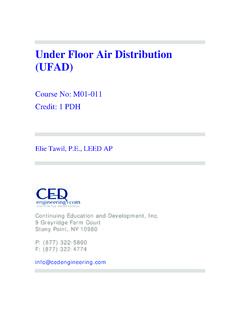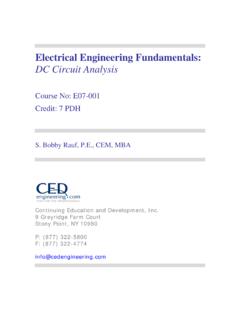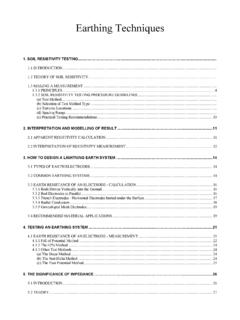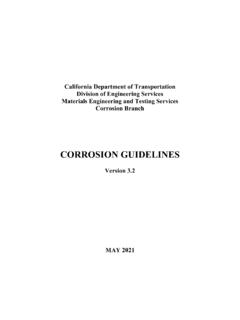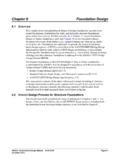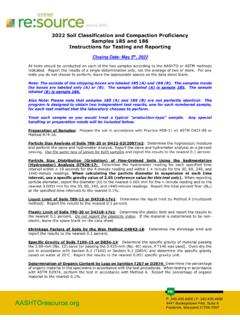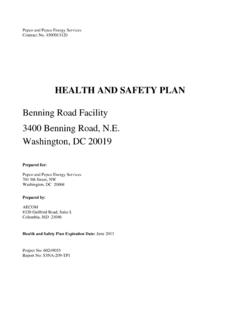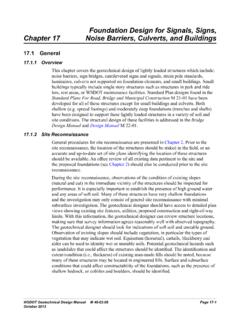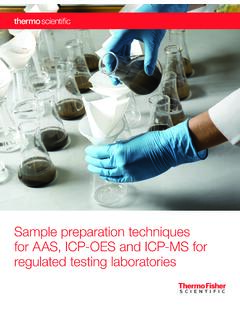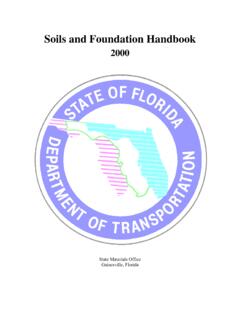Transcription of An Introduction to Cathodic Protection Inspection and Testing
1 An Introduction to Cathodic Protection Inspection and Testing Course No: E05-007 Credit: 5 PDH J. Paul Guyer, , , Fellow ASCE, Fellow AEI Continuing Education and Development, Stonewall CourtWoodcliff Lake, NJ 07677P: (877) J. Paul Guyer, , Paul Guyer is a registered civil engineer, mechanical engineer, fire Protection engineer and architect with 35 years of experience designing buildings and related infrastructure. For an additional 9 years he was a principal staff advisor to the California Legislature on capital outlay and infrastructure issues. He is a graduate of Stanford University and has held numerous national, state and local offices with the American Society of Civil Engineers, Architectural Engineering Institute and National Society of Professional Engineers.
2 An Introduction to Cathodic Protection Inspection and Testing J. Paul Guyer 2014 1 CONTENTS 1. Inspection PROCEDURES AND CRITERIA 2. APPLICABILITY 3. CRITERIA 4. OTHER CONSIDERATIONS 5. ALTERNATIVE REFERENCE ELECTRODES 6. Testing (This publication is adapted from the Unified Facilities Criteria of the United States government which are in the public domain, have been authorized for unlimited distribution, and are not copyrighted.) J. Paul Guyer 2014 2 1. Inspection PROCEDURES AND CRITERIA 1. Introduction . This discussion includes criteria and Inspection actions that, when used either separately or in combination, will indicate whether adequate Cathodic Protection of a metallic piping system has been achieved.
3 METHODS. The effectiveness of Cathodic Protection or other corrosion control measures can be affirmed by visual observation, measurements of pipe wall thickness, or by use of internal Inspection devices. Because such methods sometimes are not practical, meeting any criterion or combination of criteria in this chapter is evidence that adequate Cathodic Protection has been achieved. When excavations are made for any purpose, the pipe should be inspected for evidence of corrosion and/or coating condition. Apply sound engineering practices to determine the methods and frequency of Testing required to satisfy these criteria. THE CRITERIA in this discussion have been developed through laboratory experiments and/or verified by evaluating data obtained from successfully operated Cathodic Protection systems.
4 Situations may exist where a single criterion for evaluating the effectiveness of Cathodic Protection may not be satisfactory for all conditions. Often a combination of criteria is needed for a single structure. CORROSION LEAK HISTORY is valuable in assessing the effectiveness of Cathodic Protection . Corrosion leak history by itself, however, must not be used to determine whether adequate levels of Cathodic Protection have been achieved unless it is impractical to make electrical surveys. J. Paul Guyer 2014 3 2. APPLICABILITY. This recommended practice is intended to serve as a guide for establishing minimum requirements for control of corrosion on the following systems: NEW PIPING SYSTEMS.
5 Corrosion control by coating supplemented with Cathodic Protection , or by some other proven method, should be provided in the initial design and maintained during the service life of the piping system, unless investigations indicate that corrosion control is not required. Consideration should be given to the construction of pipelines in a manner that facilitates the use of in-line Inspection tools. EXISTING COATED PIPING SYSTEMS. Cathodic Protection should be provided and maintained, unless investigations indicate that Cathodic Protection is not required. EXISTING BARE PIPING SYSTEMS. Studies should be made to determine the extent and rate of corrosion on existing bare piping systems. When these studies indicate that corrosion will affect the safe or economic operation of the system, adequate corrosion control measures should be taken.
6 Special conditions sometimes exist where Cathodic Protection is ineffective or only partially effective. Such conditions may include elevated temperatures, disbonded coatings, thermal insulating coatings, shielding, bacterial attack, and unusual contaminants in the electrolyte. Deviation from the recommended practice may be warranted in specific situations provided that corrosion control personnel in responsible charge are able to demonstrate that the objectives expressed in the recommended practice have been achieved. J. Paul Guyer 2014 4 3. CRITERIA. The criteria described below are in accordance with the following National Association of Corrosion Engineers (NACE) standards: RP0169, Corrosion Control of External Corrosion on Underground or Submerged Metallic Piping Systems RP0285, Corrosion Control of Underground Storage Tanks By Cathodic Protection RP0388, Impressed Current Cathodic Protection of Internal Submerged Surfaces of Steel Water Storage Tanks RP0193, External Cathodic Protection of On-Grade Metallic Storage Tank Bottoms RP0196, Galvanic Anode Cathodic Protection of Internal Submerged Surfaces of Steel Water Storage Tanks Personnel responsible for corrosion control are not limited to criteria in this discussion.
7 Criteria that have been successfully applied on existing piping systems can continue to be used on those piping systems. Any other criteria used must achieve corrosion control comparable to that attained with the criteria within this chapter. STEEL AND CAST IRON PIPING. Corrosion control can be achieved at various levels of Cathodic polarization depending on the environmental conditions. However, in the absence of specific data that demonstrate that adequate Cathodic Protection has been achieved, one or more of the following shall apply: A NEGATIVE ( Cathodic ) POTENTIAL of at least 850 mV with the Cathodic Protection applied. This potential is measured with respect to a saturated copper/copper sulfate reference electrode contacting the electrolyte. Voltage drops other than those across the structure-to-electrolyte boundary must be considered for valid interpretation of this voltage measurement.
8 Note: Consideration is understood to mean the application of sound engineering practice in determining the significance of voltage drops by methods such as: Measuring or calculating the voltage drop(s); J. Paul Guyer 2014 5 Reviewing the historical performance of the Cathodic Protection system; Evaluating the physical and electrical characteristics of the pipe and its environment; and Determining whether or not there is physical evidence of corrosion. A NEGATIVE POLARIZED POTENTIAL (the potential across the structure/electrolyte interface that is the sum of the corrosion potential and the Cathodic polarization) of at least 850 mV relative to a saturated copper/copper sulfate reference electrode.
9 A MINIMUM OF -100 MV of Cathodic polarization between the structure surface and a stable reference electrode contacting the electrolyte. The formation or decay of polarization can be measured to satisfy this criterion. This criterion is not valid when bimetallic corrosion, such as when connected to copper grounding, is present. SPECIAL CONDITIONS ON BARE OR INEFFECTIVELY COATED PIPELINES where long line corrosion activity is of primary concern, the measurement of a net protective current at predetermined current discharge points from the electrolyte to the pipe surface, as measured by an earth current technique, may be sufficient. IN SOME SITUATIONS, such as the presence of sulfides, bacteria, elevated temperatures, acid environments, and dissimilar metals, the criteria in paragraph 3 may not be sufficient.
10 WHEN A PIPELINE IS ENCASED IN CONCRETE or buried in dry or aerated high resistivity soil, values less negative than the criteria listed in paragraph 3 may be sufficient. CAUTION: Using polarized potentials less negative than -850 mV is not recommended for Cathodic Protection of pipelines when operating pressures and conditions are J. Paul Guyer 2014 6 conducive to stress corrosion cracking (see references on stress corrosion cracking in this chapter). CAUTION: Use of excessive polarized potentials on coated pipelines should be avoided to minimize Cathodic disbondment of the coating. CAUTION: Polarized potentials that result in excessive generation of hydrogen should be avoided on all metals, particularly higher strength steel, certain grades of stainless steel, titanium, aluminum alloys, and pre-stressed concrete pipe.


